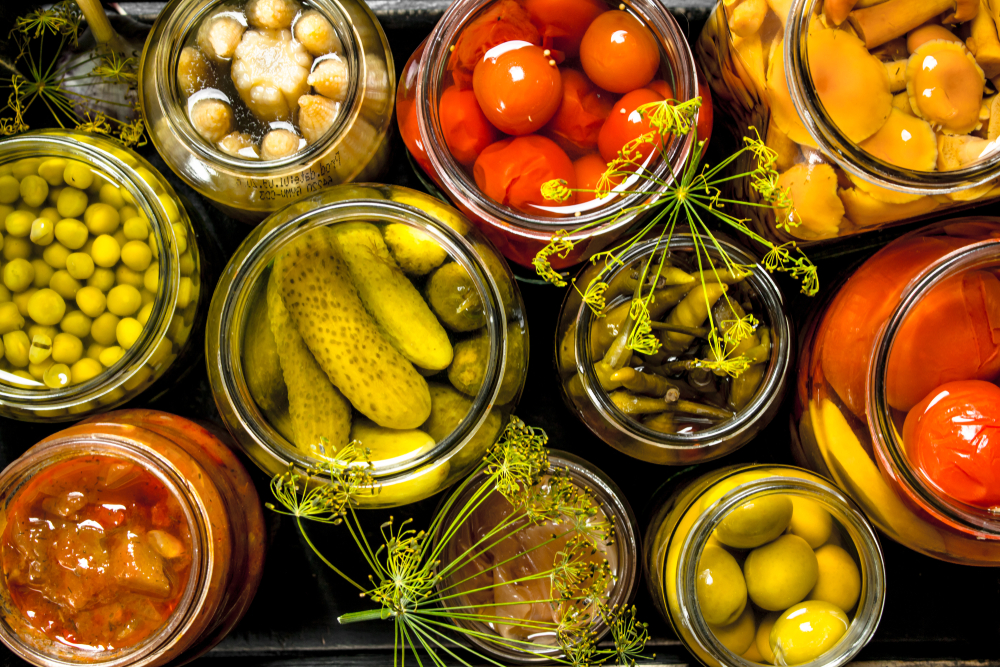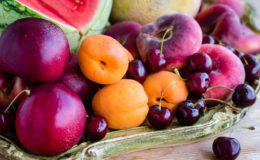“Squeamish stomachs cannot eat without pickles.” Benjamin Franklin
There’s a reason we say trust your gut. It’s home to trillions of healthy bacteria, which play a key role in helping you absorb essential vitamins, keep your immune system in tip-top shape, stay regular, and contribute to good mental health. Keeping these friendly helpers in balance may sometimes be a struggle, as Benjamin Franklin well knew, but regularly enjoying fermented foods and beverages can help bring them back into alignment and keep your systems humming with vitality.
Fermentation harnesses naturally occurring and helpful (“good”) bacteria and yeast to turn sugars and starches into alcohols and acids which helps make food more nutritious and preserve it. Thus, raw cabbage becomes kimchi or sauerkraut, cucumbers become pickles, milk becomes yogurt, and tea becomes kombucha to name but a very few.
Though these foods have gained popularity in recent years and are readily available in many grocery stores, the summer is an ideal time to try your hand at making your own. Sauerkraut, kimchi, and fermented pickles and salsa are not difficult, don’t require a lot of special equipment, and are a wonderful way to use up nature’s bounty of fresh summer veg.
Sauerkraut can be an ideal place for the beginning fermenter to start since it requires little more than cabbage, salt, and time. Though many recipes make enough to keep you in ‘kraut for many months, you may want to start with a smaller batch like this one from Emma Christensen. That’s probably not enough for my household, though, given that my husband and I bonded early on in our relationship over a shared love of sauerkraut, my daughter got top marks in a Fifth Grade science project for comparing batches made with purple and white cabbage, and I’ve even been known to sneak it into a cake!
Once you’ve mastered sauerkraut, take your skills up a notch with kimchi, the hot and spicy Korean fermented cabbage. It features prominently in Korean dishes such as tofu stew, dumplings and pancakes, but is equally delicious eaten as an accompaniment to almost any meal from scrambled eggs to spaghetti. Kimchi, like this easy version created by Emily Han, usually refers to a recipe made with Napa cabbage, but there are as many varieties of kimchi as there are people who eat it. Personalize your own batches to find one you love best, and/or to use what’s in your fridge at the moment.
Moving on from cabbage, fermented pickles vary from the standard variety more commonly found in grocery stores as they rely on naturally occurring bacteria instead of brine to transform and preserve them. Think beyond traditional pickled cucumbers to include cauliflower, carrots, peppers, jicama, fennel, parsnips, turnips, onions, green beans … whatever catches your eye at the farmers market this weekend. This recipe for mixed pickles from The Kitchn makes a half-gallon size batch.
My son and I experimented with fermented salsa earlier this year during the home schooling days of lockdown. Like the other recipes mentioned here, the salsa can be made in a simple glass jar and only needs a few days to develop. Kristin Marr’s recipe makes a fresh and tangy condiment that’s much more robust and flavorful than anything you’ve dipped a chip in before. Summer tomatoes are already one of life’s truest pleasures, and this salsa enhances their seasonal glory.
Whichever ferment you chose to tackle, it’s likely you already have most of the supplies you need: Glass jars with lids, a cutting board (wooden is my choice), a sharp knife, non-iodized kosher salt, and filtered water. The produce you chose is down to personal preference. I use the freshest veg I can find — so much the better if it’s organic and/or homegrown. Fermentation will enhance excellent produce, but even its magic cannot make sub-par vegetables sing, so don’t use anything with obvious mold or mushy spots.
I prefer using glass canning jars, but I’ve also been known to repurpose a condiment jar. When my daughter made two massive batches of sauerkraut for her science project, we invested in gallon-size glass jars, but unless you’re feeding a crowd on a regular basis, quart, pint or even half-pint jars will likely serve you well — your recipe should guide you on size and quantity of jars needed. If you develop a true passion for home fermentation, purpose-made crocks and jars are readily available online and in some large home-goods stores.
Avoid using plastic containers. Even food-grade vessels can harbor harmful bacteria in the scratches that accumulate over time, which will affect your final product. Additionally, plastic can leech chemicals into the food I’d rather not ingest. I also avoid using metal while stirring or storing my creations. Metal can not only affect the ferment, but the acid created during the process can create rust — not tasty.
Before you begin, sterilize your jars and lids. I either run them through a hot wash in the dishwasher or place them in a large roasting pan and pour boiling water over and around them. I ensure my cutting board, knife, and any measuring tools are scrupulously clean, and I take off all my jewelry and wash my hands well. But even with squeaky-clean hands I know that simply by handling the food and jars, I’ll both absorb and add to the good microbes in whatever I’m preparing, making every batch a true original.
After my vegetables are chopped and packed into my containers, I store them out of direct sunlight, in a warm but not hot place (65-75 degrees Fahrenheit is ideal). In the summer, almost any place in my kitchen meets this criteria. In the winter, I incubate them near a wall where the hot water pipes come up to the sink. No matter the season, I cover my jars with a light kitchen towel or cheesecloth. This lets air flow in, out and around, but ensures I’m not preserving any fruit flies or other insects along with my veg.
Soon you’ll notice activity. Exciting! It means your bacteria are hard at work. The liquid in your mixture might bubble or foam. If your bacteria are really active, it might bubble over the top of your jar! (For this reason I put a towel or plate under my jars.) If the mixture gets too warm or the liquid level falls below the solids, you may notice some mold forming. This is usually harmless and can be scraped off and disposed of, but use your best judgement and, yes, trust your gut.
You may wonder how you will know when your fermentation process is “done.” Though you will undoubtedly be able to see changes in texture, color and smell, how long you leave your veggies to bubble away is down to personal preference. I like to sample my mixtures along the way to find the ideal taste and texture. The veg is safe and healthy to eat at any stage, though the beneficial microbes will continue to multiply the longer you leave it. When I’ve reached the finish line (usually after just a few days), I store my creations in the fridge.
Finally, have fun! Humans have been preserving food via fermentation for thousands of years. By making your own batches of sauerkraut, kimchi, pickles or salsa this summer, you’ll not only carry on this ancient tradition, you’ll be treating yourself to a whole host of homemade health benefits. How delicious.
Resources:
- I love the ease and simplicity of recipes found in Fermentation for Beginners by Drakes Press. From cottage cheese to root beer, this small volume is packed with good advice and a wide variety of fermented foods and beverages to start you on your fermenting journey.
- Though single veg ferments like sauerkraut are undoubtedly healthy and delicious, you increase your microbiome exponentially by eating kimchi and mixed veg since each ingredient brings something a little different to the finished product.
- In the same vein, eating a little fermented food everyday is more beneficial than a lot once in a while, as it tops up your good bacteria and keeps them consistently happy — all the more reason to always have a jar of something bubbling away on the counter.
- Sauerkraut cake? I knew you’d be interested. It’s from domestic doyenne (and syndicated columnist) Heloise. I’m sure it’s not the healthiest way to serve ‘kraut, but it works a treat if you happen to have any leftovers (or want to convert sauerkraut haters — they’ll never know there’s cabbage in with the chocolate).
by Stefin Kohn, Contributing Writer







